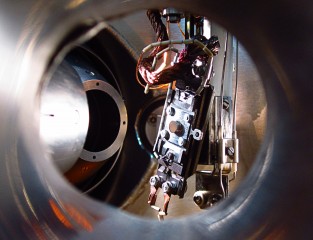Feb 12 2014
Shoot a beam of light or particles at certain special materials and you will liberate electrons -- pairs of them -- a phenomenon known as "electron pair emission, " which can reveal fundamental properties of the solid and reveal information necessary to design novel materials for future applications.
 A view inside the photoemission chamber, “Hydra,” shows the entry point for one time-of-flight electron spectrometer (on the left, opposite the larger open round hole), as well as a second time-of-flight electron spectrometer (on the left front side looking toward the sample, which is a round silver crystal covered by an ultrathin layer of nickel oxide). M.Huth/Max Planck
A view inside the photoemission chamber, “Hydra,” shows the entry point for one time-of-flight electron spectrometer (on the left, opposite the larger open round hole), as well as a second time-of-flight electron spectrometer (on the left front side looking toward the sample, which is a round silver crystal covered by an ultrathin layer of nickel oxide). M.Huth/Max Planck
Measuring electron pair emission has always been difficult, however, because they were traditionally done using highly expensive synchrotron light sources, which are available in only a few laboratories worldwide. Nobody has found a way to routinely measure electron pair interactions on a standard lab bench.
Now a team led by researchers at the Max Planck Institute of Microstructure Physics in Halle, Germany has done just that. They developed a new way to measure the emission of electron pairs directly by combining two common laboratory instruments called time-of-flight spectrometers, a setup they describe in the journal Applied Physics Letters, which is produced by AIP Publishing.
“Einstein received the Nobel Prize for his explanation of the photoelectric effect, which was published in 1905. Einstein considered the possibility that the photon energy can be transferred to more than one electron,” explained Michael Huth, a postdoctoral researcher at the Max Planck Institute of Microstructure Physics. “The existence of this process provides direct access to the electron correlation strength.”
An electron pair is “excited” by a single photon; from an experimental point of view, this requires the combination of a suitable light source and electron spectrometers.
Developing such a setup involved “a significant effort,” according to Huth. Comically, the team dubbed their setup’s photoemission chamber “Hydra,” because its two time-of-flight spectrometers give the chamber an appearance of having multiple heads.
As a proof-of-principle experiment, the team chose to investigate nickel oxide (NiO), which, in theory, should have strong electron correlation effects. While measuring the energy distribution, they were surprised to discover that in contrast to the metal, the energy sum of the electron pair shows no prominent features.
What’s the significance? “Our observation is that metals and nickel oxide behave very differently,” Huth said. “This implies that our technique allows us to quantify the electron correlation strength.”
Quantifying a solid-state material's electron correlation strength is important because it allows researchers to characterize its useful properties, including superconductivity, metal-insulator transition and long-range magnetic ordering. “Our experimental data will guide theory toward understanding the fundamental properties of solids, and one day help to design novel functional materials,” Huth noted.
Next, the researchers’ sights are set on exploring different materials to gain a more complete picture of electron correlation by running experiments at different photon energies. “We also plan to optimize the efficiency and stability of our new setup for ongoing experiments,” Huth said.
The article, "Electron pair emission detected by time-of-flight spectrometers: Recent progress" by Michael Huth, Cheng-Tien Chiang, Andreas Trützschler, Frank O. Schumann, Jürgen Kirschner, and Wolf Widdra appears in the journal Applied Physics Letters (DOI: 10.1063/1.4820430). The article will be published online on February 11, 2014. After that date, it can be accessed at: http://tinyurl.com/qz8qlx9
Authors of this paper are affiliated with the Max Planck Institute of Microstructure Physics and the University Halle-Wittenberg.
ABOUT THE JOURNAL
Applied Physics Letters features concise, rapid reports on significant new findings in applied physics. The journal covers new experimental and theoretical research on applications of physics phenomena related to all branches of science, engineering, and modern technology. See: http://apl.aip.org